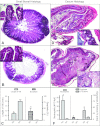Conditional knockout of the Slc5a6 gene in mouse intestine impairs biotin absorption
- PMID: 23104561
- PMCID: PMC3543636
- DOI: 10.1152/ajpgi.00379.2012
Conditional knockout of the Slc5a6 gene in mouse intestine impairs biotin absorption
Abstract
The Slc5a6 gene expresses a plasma membrane protein involved in the transport of the water-soluble vitamin biotin; the transporter is commonly referred to as the sodium-dependent multivitamin transporter (SMVT) because it also transports pantothenic acid and lipoic acid. The relative contribution of the SMVT system toward carrier-mediated biotin uptake in the native intestine in vivo has not been established. We used a Cre/lox technology to generate an intestine-specific (conditional) SMVT knockout (KO) mouse model to address this issue. The KO mice exhibited absence of expression of SMVT in the intestine compared with sex-matched littermates as well as the expected normal SMVT expression in other tissues. About two-thirds of the KO mice died prematurely between the age of 6 and 10 wk. Growth retardation, decreased bone density, decreased bone length, and decreased biotin status were observed in the KO mice. Microscopic analysis showed histological abnormalities in the small bowel (shortened villi, dysplasia) and cecum (chronic active inflammation, dysplasia) of the KO mice. In vivo (and in vitro) transport studies showed complete inhibition in carrier-mediated biotin uptake in the intestine of the KO mice compared with their control littermates. These studies provide the first in vivo confirmation in native intestine that SMVT is solely responsible for intestinal biotin uptake. These studies also provide evidence for a casual association between SMVT function and normal intestinal health.
Figures





References
-
- Arumugam M, Raes J, Pelletier E, Le Paslier D, Yamada T, Mende DR, Fernandes GR, Tap J, Bruls T, Batto JM, Bertalan M, Borruel N, Casellas F, Fernandez L, Gautier L, Hansen T, Hattori M, Hayashi T, Kleerebezem M, Kurokawa K, Leclerc M, Levenez F, Manichanh C, Nielsen HB, Nielsen T, Pons N, Poulain J, Qin J, Sicheritz-Ponten T, Tims S, Torrents D, Ugarte E, Zoetendal EG, Wang J, Guarner F, Pedersen O, de Vos WM, Brunak S, Doré J, Met Consortiuma HIT, Antolín M, Artiguenave F, Blottiere HM, Almeida M, Brechot C, Cara C, Chervaux C, Cultrone A, Delorme C, Denariaz G, Dervyn R, Foerstner KU, Friss C, van de Guchte M, Guedon E, Haimet F, Huber W, van Hylckama-Vlieg J, Jamet A, Juste C, Kaci G, Knol J, Lakhdari O, Layec S, Le Roux K, Maguin E, Mérieux A, Melo Minardi R, M'rini C, Muller J, Oozeer R, Parkhill J, Renault P, Rescigno M, Sanchez N, Sunagawa S, Torrejon A, Turner K, Vandemeulebrouck G, Varela E, Winogradsky Y, Zeller G, Weissenbach J, Ehrlich SD, Bork P. Enterotypes of the human gut microbiome. Nature 473: 174–180, 2011 - PMC - PubMed
-
- Balamurugan K, Ortiz A, Said HM. Biotin uptake by human intestinal and liver epithelial cells: role of the SMVT system. Am J Physiol Gastrointest Liver Physiol 285: G73– G77, 2003 - PubMed
-
- Berdanier CD. Water-soluble vitamins. In: Advanced Nutrition Micronutrients, edited by Berdanier CD. New York: CRC, 1998, p. 73–124
-
- Bonjour JP. Vitamins and alcoholism. V Riboflavin, VI Niacin, VII Pantothenic acid, and VIII Biotin. Internal J Vit Nutr 50: 425– 440, 1980 - PubMed
Publication types
MeSH terms
Substances
Grants and funding
LinkOut - more resources
Full Text Sources
Other Literature Sources
Molecular Biology Databases
Research Materials

